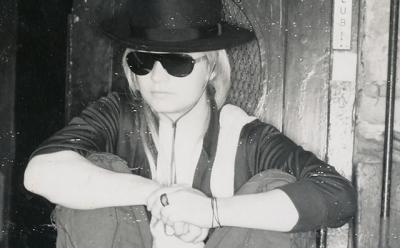SummerDocs Unpacks a Literary Deception

In October 2005, Stephen Beachy, writing in New York magazine, asked, “Who is the real JT Leroy?” and proposed an answer. A few months later, The New York Times called the Leroy enigma “one of the most bizarre literary mysteries in recent memory” and Vanity Fair dubbed it the “literary parlor game of ‘Who Is JT Leroy?’ ”
It has been 10 years since the questions were answered and the story told. “JT Leroy,” a 20-year-old boy with a troubled past and sordid present who went on to write novels, stories, magazine articles, and screenplays, was actually the nom de plume of Laura Albert, a former punk rocker and phone-sex operator. When the presumed Leroy appeared in public, disguised by a wig and sunglasses, he was actually Savannah Knoop, the half-sister of Ms. Albert’s then-husband.
Now 50, Ms. Albert tells her own story for the first time in “Author: The JT Leroy Story,” a documentary by Jeff Feuerzeig that will be shown at Guild Hall on July 9 at 7 p.m. as the opener of this year’s SummerDocs series, a program of the Hamptons International Film Festival. Mr. Feuerzeig will speak about the film with Alec Baldwin and David Nugent, the festival’s artistic director, after the screening.
Mr. Feuerzeig and Mr. Nugent were vaguely aware of the story when it broke. “And then I sort of lost the thread,” Mr. Nugent said recently. “It was complicated, and you had to follow it along, and I just didn’t. When I saw it at Sundance, it was such an eye-opening experience.”
“I had not heard of JT Leroy or the story,” said the director. “But a friend of mine, a journalist, turned me on to it, and I’m very attracted to truth-is-stranger-than-fiction stories. It generated a lot of ink at the time, and all these publications weighed in on it. But Laura had held her story back, and nobody had heard her side of it. I thought, ‘That’s the voice I’d like to hear.’ ”
Mr. Feuerzeig made contact with Ms. Albert and sent her his film “The Devil and Daniel Johnston,” which won top-documentary directing honors at Sundance in 2005. A portrait of a schizophrenic musician and outsider artist, “it deals quite vividly with the intersection of madness and creativity,” said Mr. Feuerzeig. “It really spoke to her, so she decided to share her story with me.” Ms. Albert had previously been approached not only by other documentarians but also by Hollywood, but she turned everybody down.
Mr. Feuerzeig’s approach to his subjects reflects the influence of the New Journalism of writers such as Tom Wolfe, Gay Talese, Terry Southern, Joan Didion, and Nick Tosches, among others, who discarded objectivity for a more subjective and literary approach. “It’s a subjective film,” said Mr. Feuerzeig, “which I’m proud of. She chose to share everything.” Ms. Albert likes the film and attended both the Sundance premiere and a showing at the Brooklyn Academy of Music two weeks ago.
“Jeff is a very powerful filmmaker,” said Mr. Nugent. “I think he did such a good job of capturing and crystallizing something that’s not such an easy story to tell. And I think audiences who are media-savvy and into fashion, literature, and celebrity will find it to be a very interesting film.”
Mr. Nugent and Mr. Baldwin start planning the SummerDocs series by watching many of the films at Sundance, “where a lot of the best docs premiere,” Mr. Nugent said. “I see as many as I can, and afterward follow up and request many of the films I missed. We look at them and talk about them.” He noted that in addition to quality, a film must lend itself to discussion, since SummerDocs question-and-answer sessions are expected to take half an hour or longer. They also seek a balance each year “so that people who are really passionate about documentaries, as Alec and I are, will get a good sample of the variety of films out there.”
